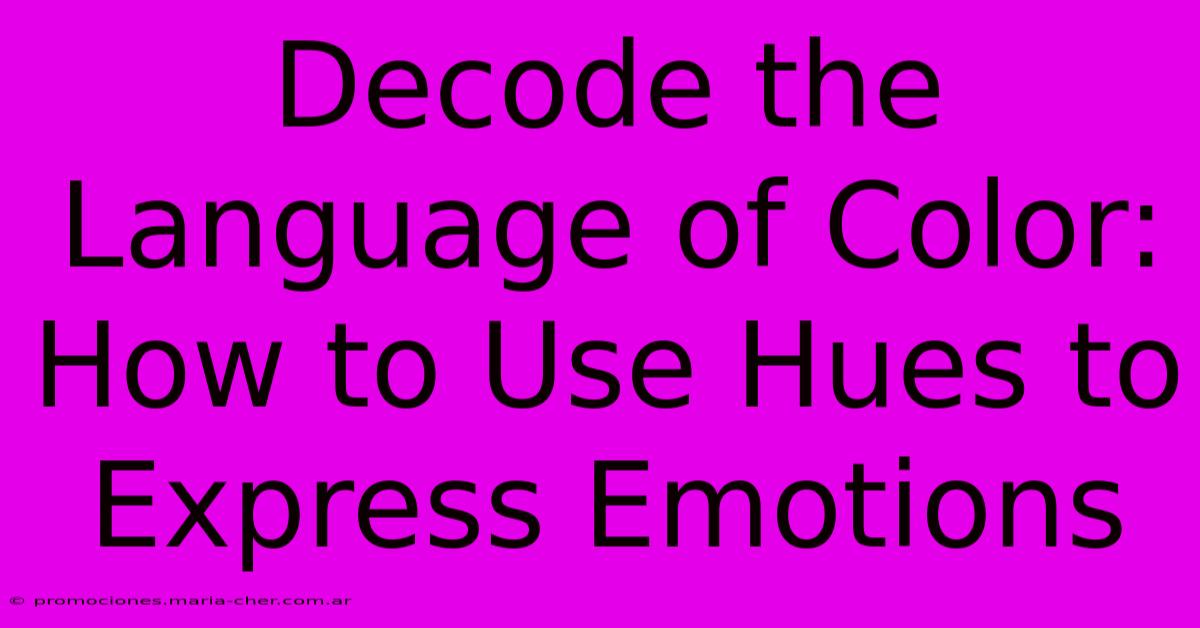Decode The Language Of Color: How To Use Hues To Express Emotions

Table of Contents
Decode the Language of Color: How to Use Hues to Express Emotions
Color is more than just a visual element; it's a powerful communication tool that evokes emotions, influences perceptions, and shapes our experiences. Understanding the psychology of color and how different hues impact our feelings is crucial for effective design, marketing, and even personal expression. This article delves into the language of color, exploring how to harness its power to convey specific emotions and achieve your desired effect.
The Psychology of Color: A Quick Guide
Different colors trigger different responses in our brains. This is due to a complex interplay of cultural associations, personal experiences, and biological factors. While interpretations can vary slightly across cultures, some general associations are widely recognized:
Warm Colors: Energy and Passion
-
Red: Often associated with passion, energy, excitement, and urgency. It's a bold color that grabs attention but can also be perceived as aggressive or warning in high saturation. Think of stop signs or fire engines – instant reactions! Use red strategically to highlight important elements or evoke a sense of urgency.
-
Orange: Projects a feeling of enthusiasm, creativity, and playfulness. It’s a more approachable warm color than red, often used to convey friendliness and affordability.
-
Yellow: Represents joy, optimism, and intellectual stimulation. However, overuse can lead to feelings of anxiety or frustration. It’s great for highlighting information or creating a cheerful atmosphere.
Cool Colors: Calmness and Serenity
-
Blue: Evokes feelings of trust, calmness, stability, and security. Often associated with professionalism and reliability, blue is widely used in corporate branding and healthcare settings.
-
Green: Represents growth, harmony, nature, and freshness. It's associated with peace and tranquility, making it ideal for relaxation and wellness-related contexts.
-
Purple: Often linked to luxury, royalty, creativity, and wisdom. Its use can project sophistication and elegance.
Neutral Colors: Balance and Sophistication
-
Black: Conveys power, sophistication, elegance, and mystery. It can also represent formality and authority, but overuse can feel oppressive.
-
White: Often signifies purity, cleanliness, simplicity, and minimalism. It creates a sense of spaciousness and calmness.
-
Gray: Represents neutrality, balance, sophistication, and stability. It's versatile and can be used to create a sense of calm or to complement brighter colors.
Using Color to Express Emotions in Design and Marketing
The skillful application of color is vital in various fields:
Website Design:
Consider your website's purpose. A website for a yoga studio would likely benefit from calming greens and blues, while a gaming website might utilize vibrant reds and oranges. Strategic color choices guide user experience and brand perception.
Branding and Logo Design:
Your brand's color palette should reflect its values and target audience. A luxury brand might utilize deep purples and golds, whereas a playful children's brand might opt for bright yellows and oranges.
Marketing Materials:
Color psychology can significantly impact the effectiveness of your marketing campaigns. Using appropriate colors to evoke the desired emotions can boost engagement and conversions. For example, a sale announcement might use red to highlight urgency.
Art and Personal Expression:
Color is a powerful tool for artists to express their feelings and ideas. The emotional impact of a painting or drawing is deeply intertwined with the artist's color choices.
Beyond the Basics: Context Matters
Remember that color perception isn't solely determined by the hue itself; context plays a crucial role. The saturation, brightness, and surrounding colors all contribute to the overall emotional response. A dark, muted blue might feel different than a bright, vibrant blue.
Conclusion: Mastering the Language of Color
Understanding the language of color is a valuable skill that enhances creative expression and communication. By learning to harness the power of different hues, you can create designs and marketing materials that not only look aesthetically pleasing but also effectively connect with your audience on an emotional level. Experiment, observe, and most importantly, let your creativity flow! Remember to always test and refine your approach, analyzing the reactions of your target audience to ensure optimal impact.

Thank you for visiting our website wich cover about Decode The Language Of Color: How To Use Hues To Express Emotions. We hope the information provided has been useful to you. Feel free to contact us if you have any questions or need further assistance. See you next time and dont miss to bookmark.
Featured Posts
-
Discover The Secrets Of Thinking Fast And Slow An Aussie Approach
Feb 09, 2025
-
Unveiling The Magic Of Fotolia A Step By Step Tutorial To Maximize Your Visual Impact
Feb 09, 2025
-
Fierce And Feminine The Enchanting Power Of Orange Gel Nails
Feb 09, 2025
-
Growth Scan At A Price That Will Make Your Cfo Smile
Feb 09, 2025
-
Gel Builders Guide For Beginners Elevate Your Nail Game
Feb 09, 2025
